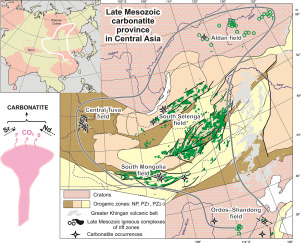当前位置:
X-MOL 学术
›
Gondwana Res.
›
论文详情
Our official English website, www.x-mol.net, welcomes your
feedback! (Note: you will need to create a separate account there.)
Late Mesozoic carbonatite provinces in Central Asia: Their compositions, sources and genetic settings
Gondwana Research ( IF 7.2 ) Pub Date : 2019-05-01 , DOI: 10.1016/j.gr.2018.11.014 A.V. Nikiforov , V.V. Yarmolyuk
Gondwana Research ( IF 7.2 ) Pub Date : 2019-05-01 , DOI: 10.1016/j.gr.2018.11.014 A.V. Nikiforov , V.V. Yarmolyuk

|
Abstract Identification of the Late Mesozoic carbonatite province in Central Asia is herein discussed. Its regional extent and distribution is investigated, and the areas with manifestations of carbonatite magmatism are described. It is shown that they were developed in terranes with heterogeneous and heterochronous basements: Siberian (Aldan Shield) and North China cratons; Early Paleozoic (Caledonian) and Middle–Late Paleozoic (Hercynian) structures of the Central Asian fold belt (Transbaikal and Tuva zones in Russia; Mongolia). Irrespective of the structural position, the carbonatites were generated within a relatively narrow time interval (150–118 Ma). The geochemical (Sr, LREE, Ba, F and P) specialization of carbonatites of the province is reflected in their mineral composition. Some rocks of the carbonatite complexes always include one or more distinctive minerals: fluorite, Ba–Sr sulfates, Ba–Sr–Ca carbonates, LREE fluorocarbonates, or apatite. Compared to counterparts from other age groups (for example, Maimecha–Kotui group in North Asia), these carbonatites are depleted in Ti, Nb, Ta, Zr and Hf. It is shown that the Sr and Nd isotope composition of carbonatites correlates with the geological age of the host crust. Rocks of carbonatite complexes associated with cratons are characterized by the lowest eNd(T) and highest ISr(T) values, indicating that their formation involved an ancient lithospheric material. Carbonatite magmatism occurred simultaneously with the largest plateau basalts 130–120 Ma ago in rift zones in the Late Mesozoic intraplate volcanic province of Central Asia. This interval corresponds to timing of global activation of intraplate magmatism processes, suggesting a link of the carbonatite province with these processes. It is shown that fields with the carbonatite magmatism were controlled by small mantle plumes (“hot fingers”) responsible for the Central Asian mantle plume events.
中文翻译:

中亚晚中生代碳酸岩省:它们的组成、来源和成因背景
摘要 本文讨论了中亚晚中生代碳酸岩省的鉴定。考察了其区域范围和分布,描述了碳酸盐岩岩浆活动表现的地区。表明它们发育于具有异质和异时基底的地体中:西伯利亚(阿尔丹地盾)和华北克拉通;中亚褶皱带(俄罗斯外贝加尔湖和图瓦地区;蒙古)的早古生代(加里东期)和中-晚古生代(海西期)构造。无论结构位置如何,碳酸岩都是在相对较窄的时间间隔(150-118 Ma)内生成的。该省碳酸盐岩的地球化学特征(Sr、LREE、Ba、F 和 P)反映在它们的矿物组成上。一些碳酸盐岩复合体的岩石总是包含一种或多种独特的矿物:萤石、Ba-Sr 硫酸盐、Ba-Sr-Ca 碳酸盐、LREE 氟碳酸盐或磷灰石。与其他年龄组的对应物(例如北亚的 Maimecha-Kotui 组)相比,这些碳酸岩缺乏 Ti、Nb、Ta、Zr 和 Hf。结果表明,碳酸岩的 Sr 和 Nd 同位素组成与寄主地壳的地质年龄有关。与克拉通相关的碳酸盐岩复合岩的特征是最低的 eNd(T) 和最高的 ISr(T) 值,表明它们的形成涉及古老的岩石圈物质。碳酸岩岩浆作用与最大的高原玄武岩在 130-120 Ma 前同时发生在中亚晚中生代板内火山区的裂谷带。该区间对应于板内岩浆活动过程的全球激活时间,表明碳酸盐岩省与这些过程之间存在联系。结果表明,碳酸盐岩岩浆活动场是由引起中亚地幔柱事件的小地幔柱(“热指”)控制的。
更新日期:2019-05-01
中文翻译:

中亚晚中生代碳酸岩省:它们的组成、来源和成因背景
摘要 本文讨论了中亚晚中生代碳酸岩省的鉴定。考察了其区域范围和分布,描述了碳酸盐岩岩浆活动表现的地区。表明它们发育于具有异质和异时基底的地体中:西伯利亚(阿尔丹地盾)和华北克拉通;中亚褶皱带(俄罗斯外贝加尔湖和图瓦地区;蒙古)的早古生代(加里东期)和中-晚古生代(海西期)构造。无论结构位置如何,碳酸岩都是在相对较窄的时间间隔(150-118 Ma)内生成的。该省碳酸盐岩的地球化学特征(Sr、LREE、Ba、F 和 P)反映在它们的矿物组成上。一些碳酸盐岩复合体的岩石总是包含一种或多种独特的矿物:萤石、Ba-Sr 硫酸盐、Ba-Sr-Ca 碳酸盐、LREE 氟碳酸盐或磷灰石。与其他年龄组的对应物(例如北亚的 Maimecha-Kotui 组)相比,这些碳酸岩缺乏 Ti、Nb、Ta、Zr 和 Hf。结果表明,碳酸岩的 Sr 和 Nd 同位素组成与寄主地壳的地质年龄有关。与克拉通相关的碳酸盐岩复合岩的特征是最低的 eNd(T) 和最高的 ISr(T) 值,表明它们的形成涉及古老的岩石圈物质。碳酸岩岩浆作用与最大的高原玄武岩在 130-120 Ma 前同时发生在中亚晚中生代板内火山区的裂谷带。该区间对应于板内岩浆活动过程的全球激活时间,表明碳酸盐岩省与这些过程之间存在联系。结果表明,碳酸盐岩岩浆活动场是由引起中亚地幔柱事件的小地幔柱(“热指”)控制的。











































 京公网安备 11010802027423号
京公网安备 11010802027423号